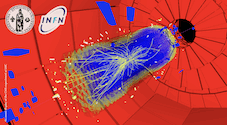Speaker
Dr
Riccardo Mori
(INFN Firenze and Dip Energetica Univ. Firenze)
Description
Investigation on the influence of defect states on the electrical properties of disordered semiconductor materials is strategic in the perspective of increasing the efficiency of devices in several application fields as clinical radiotherapy (a-Si, polycrystalline diamond..), solar cells ( a-Si, nanostructured TiO2, .. ) , particle detectors (Si, SiC ...). It is well known that materials used for radiation detection suffer of radiation damage effects due to the formation of localized defects and clusters. Multi trapping mechanisms at localized states are responsible of polarization, slow dynamics and degradation of the efficiency. Combined conduction mechanisms related to extended state diffusive transport and localized state hopping transport can occur. Moreover, in such heavily disordered systems, conduction and valence band tails have to be taken into account. Thermally Stimulated Currents is a powerful tool to investigate defects responsible for conduction mechanisms. In this work we develop a model which explains the TSC spectra observed at low temperature by taking into account of both hopping, dispersive conduction and band tail filling. Measurements after illumination with a UV Xe lamp have been carried out on nanostructured TiO2 films in the temperature range 10-300K. Our model, not being based on specific assumptions, can be extended to investigate the incidence of extended defects in the electrical behaviour of heavily irradiated semiconductors used for particle detection and dosimetry.
Author
Dr
Riccardo Mori
(INFN Firenze and Dip Energetica Univ. Firenze)
Co-authors
Mr
Alessandro Cavallaro
(INFN Firenze and Dip Energetica Univ. Firenze)
Prof.
Franco Bogani
(Dip. Energetica Univ Firenze)
Prof.
Mara Bruzzi
(INFN Firenze and Dip Energetica Univ. Firenze)
Dr
Monica Scaringella
(INFN Firenze and Dip Energetica Univ. Firenze)

